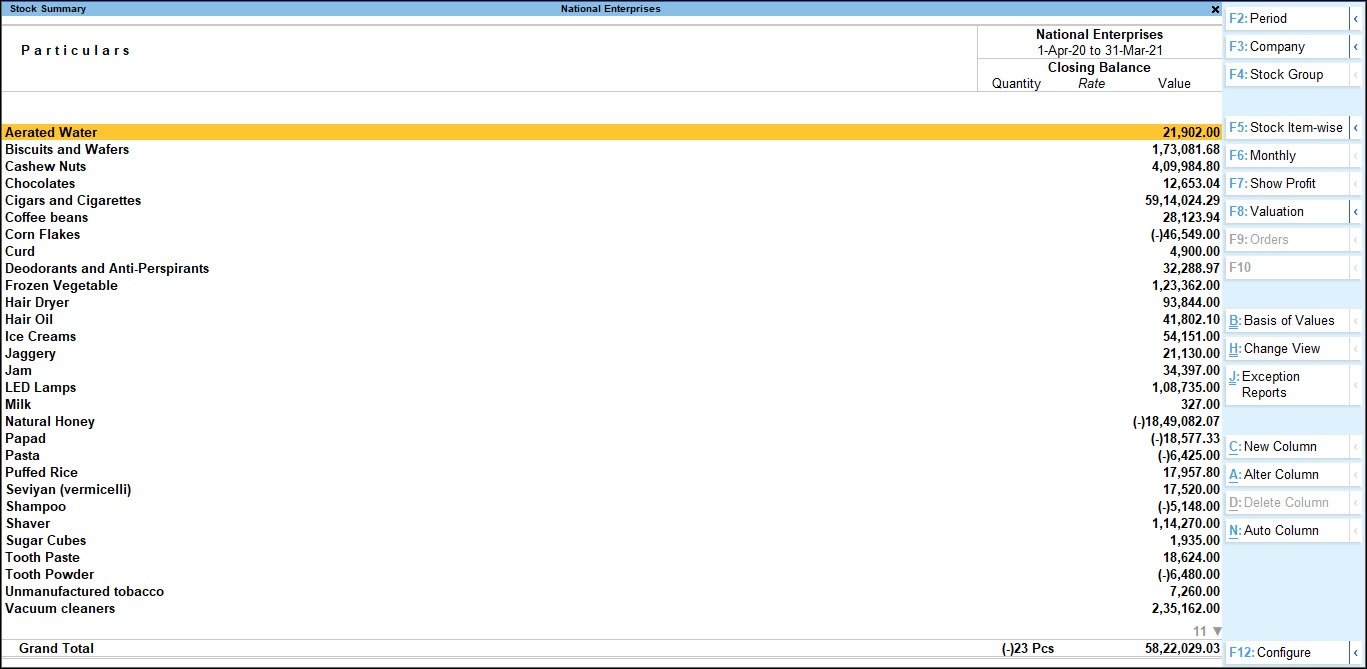Track Your Inventory | Stock Summary
Stock Summary is a statement of the real-time stock-in-hand on a particular day. It is one of the primary inventory statements that gets updated in real-time as and when you record transactions. If you have maintained the inventory in groups, transferred stock for various business needs, sold or purchased stock items, TallyPrime helps you view all of them using the Stock Summary report. You can view this report in the browser.
Know your stock details: Stock Summary provides information on stock items such as quantity, rate, and opening and closing value of the stock items. You can view the entire stock flow, including goods inward, goods outward, opening stock, and closing stock. Whether it is about stock reordering or stock ageing, you can get the right information about the inventory in your business using this report. You can understand the movement of a particular item day-on-day, month-wise or for any selected period.
Understand sales and purchases of stock: You can view details of the available stock at different locations and make a purchase or sales decision accordingly. A clear view of the purchase and sales order outstanding helps you further decide on the next steps to improve the cash flow in your business.
Know stock-wise profit: When you make business transactions with your vendors, you will need to keep a tab on your profit margins regularly. Understanding the profit value against the sales and purchase value of the items help in maintaining your future transactions. Using the Stock Summary report, you can view the profit made from sales of stock items, individually or per group.
Similar to all other reports in TallyPrime, you can drill-down from the Stock Summary report to view various inventory information as per your business needs.
Know Your Stock Summary
Whether you maintain your stock individually or in groups, you will be able to know the opening and closing balance of your stock on any given day. In the Stock Summary report, you can view the stock balance and profits made from sales of your stock. The report also helps you to know the available stock quantity, the pending sales and purchase orders, and how much stock is available for supplying to your customers.
In this section
View Stock Summary
- Gateway of Tally > Stock Summary.
Alternatively, Alt+G (Go To) > type or select Stock Summary and press Enter.
By default, the Stock Summary report displays the item-wise summary – list of stock items with their corresponding closing balance details.
What you see on the screen can vary based on your choices. Press F12 (Configure) to change the options and F11 (Features) to enable or disable features.
If you have maintained items in groups, you will see the data based on the stock groups you have created for your business.
Say you have created the stock items under the stock groups – Aerated Water, Biscuits and Wafers, and Cashew Nuts – as shown below:
|
Aerated Water |
Biscuits and Wafers |
Cashew Nuts |
|
Cococola 300ml Tin |
50-50 Biscuits |
Regular 200 gms |
|
Cococola 700ml |
Bourbon Biscuits |
Regular 500 gms |
|
Fanta 300ml Tin |
|
Salted 200 gms |
|
|
|
Salted 500 gms |
In this case, the default summary report will display the group-wise closing balance of the stock.
Note: The value of the closing stock shown in Stock Summary is also displayed in the Profit and Loss report. If you do not see the same value in the Profit and Loss report, ensure that you have set the following option: Press F11 (Features) > set Integrate Accounts with Inventory to Yes.
Explore report details
Explode/Collapse
- Press Shift+Enter on the selected stock item or stock group to see the next level of data on the same screen. You can move to any of the lines in the next level and further explode the selected line using Shift+Enter, until the last level of data.
- In the example mentioned earlier, stock items have been created under different stock groups. You can press Shift+Enter on the stock group Biscuits and Wafers and continue to see the last level of data under that group. A sample image is shown below.
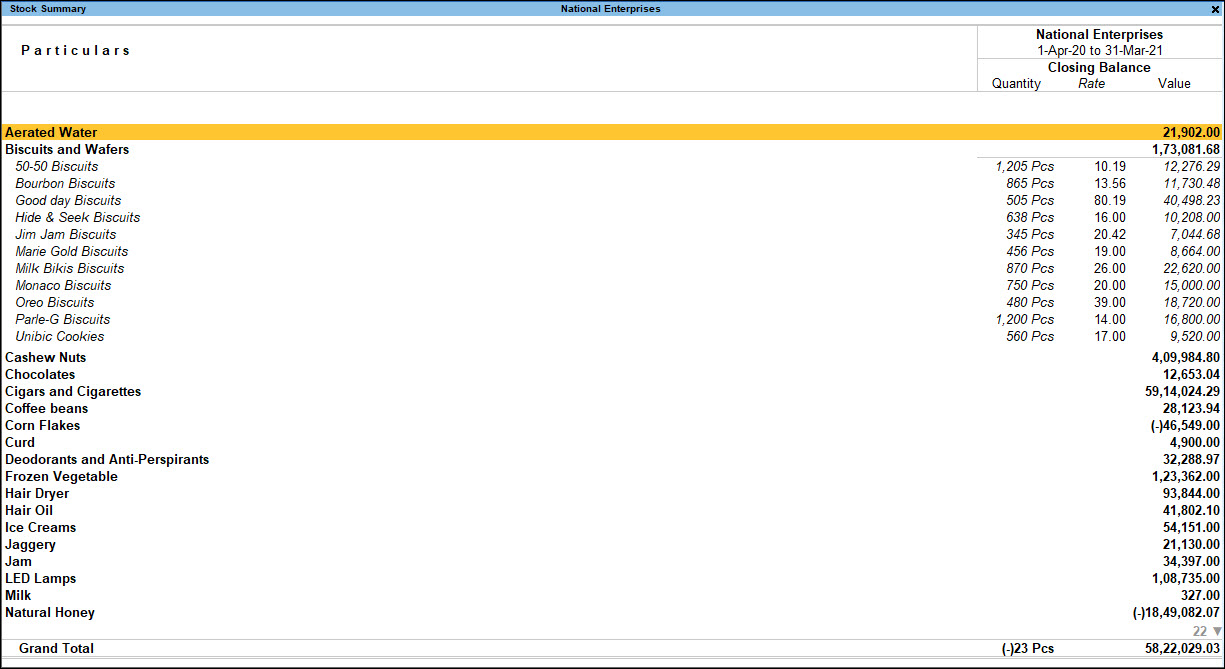
What you see on the screen can vary based on your choices. Press F12 (Configure) to change the options and F11 (Features) to enable or disable features.
- Press Enter on the selected stock group to show the next level of data in a new screen. For example, if you press Enter on Biscuits and Wafers, the stock items under that group will be shown in a new screen.

What you see on the screen can vary based on your choices. Press F12 (Configure) to change the options and F11 (Features) to enable or disable features.
- Pressing Enter on the last level of data (that is the stock item in this case) opens the monthly summary report, as in the case of other summary reports.
- Press Alt+F5 (Detailed) in the Stock Summary report to view the next level of data for all the stock groups or items appearing in the report. Further, use F12 (Configure) > set Expand all levels in Detailed format to Yes to see all levels of the data. As always, you can toggle between the Detailed and Condensed formats of the reports by pressing Alt+F5. A sample image is shown below.
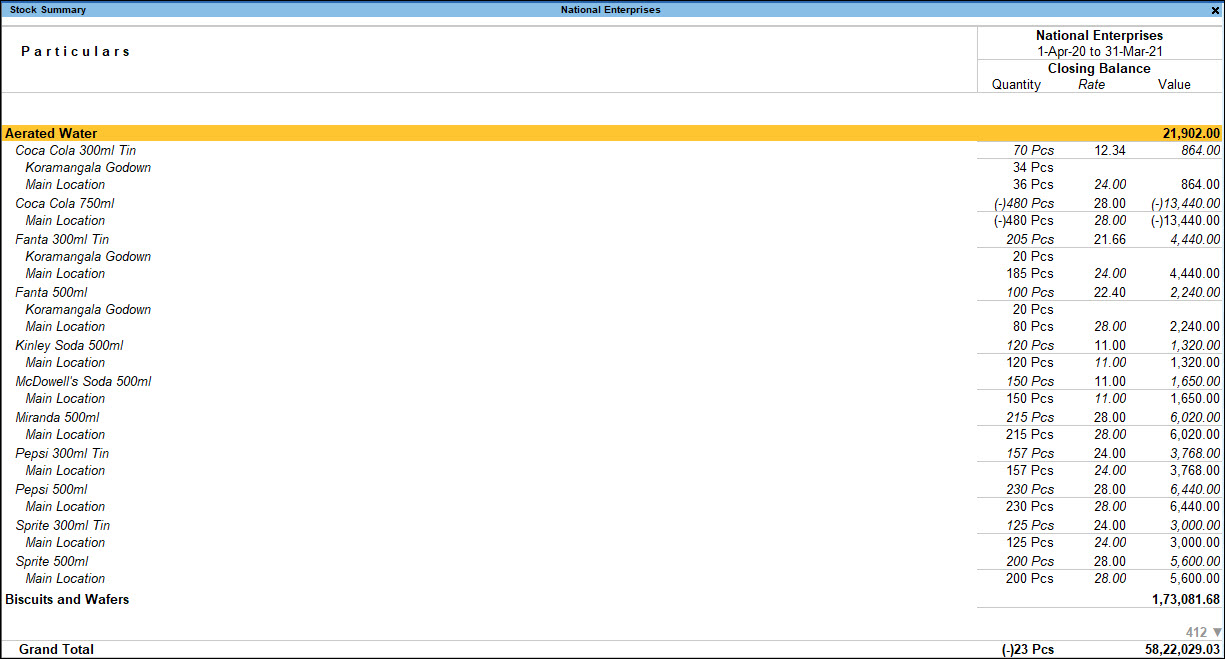
What you see on the screen can vary based on your choices. Press F12 (Configure) to change the options and F11 (Features) to enable or disable features.
Alter master from summary report
- Select a stock item or stock group in the report, and press Ctrl+Enter to alter.
Configure Stock Summary for Additional Details
Change period
- Press F2 (Period) in the Stock Summary report to specify the period, and view the report for that period.
Change company
When you have two or more companies open, press F3 (Company) to change from one company to another.
When you are viewing the Stock Summary of National Enterprises and want to view the Stock Summary of National Tradings & Co.
- Press F3 (Company) > and select National Tradings & Co.
The Stock Summary report for National Tradings & Co. will be displayed without you having to close the earlier company. As always, you can press Esc to go back to the Stock Summary report of National Enterprises.
Change report context
When you have stock items in groups, your can view details of any selected stock group.
- Press F4 (Stock Group) and select a stock group to view the closing balance of the items under that stock group.
View stock details item-wise or group-wise
When you maintain stock items in different groups, you can toggle between the item-wise and group-wise view of the summary report.
- Press F5 (Stock Item-wise) to view the summary item-wise.
- From the item-wise view, press F5 (Stock Group-wise) to view the summary group-wise.
View profitability
Whether you have grouped your stock items or maintained them individually, it becomes tedious to track the profit manually.
- Press F7 (Show Profit) to see the profit earned from your outward stock, including the consumptions made. This statement is used to reconcile the closing balance because the closing value is derived by taking the consumption values instead of the outward goods at sales value. You can use F7 (Hide Profit) to hide the profit-related details.

What you see on the screen can vary based on your choices. Press F12 (Configure) to change the options and F11 (Features) to enable or disable features.
Ctrl+B (Basis of Values)
You can configure the values in your report for that instance, based on different business needs.
- In Stock Summary, you can display the amounts in reports in Millions or Hundreds. Press Ctrl+B (Basis of Values) > Scale Factor > select Millions. Press Esc to view the default values.
- Similarly, you can select different Valuation Methods to display and compare the effect on your report values. Press Ctrl+B (Basis of Values) > Stock Valuation Method > select LIFO, FIFO, or Avg Price, as needed. Press Esc to view the default values.
Ctrl+H (Change View)
You can display the details of a report in different views with additional details or for a specific period. You can also view other reports related to the current report.
- To view the Monthly Summary report, press Ctrl+H (Change View) > type or select Monthly Summary> press Enter. Press Esc to view the default report.
- You may also want to get an insight of the stock movements, receivables, payables, or even cash flow based on your sales. This will help you reconcile the summarised data in the summary report based on the specific information available under Related Reports.
Ctrl+J (Exception Reports)
You can view the exceptions related to the data displayed in the current report by pressing Ctrl+J (Exception Reports), without closing the report.
- To view the Negative Ledger, press Ctrl+J (Exception Reports) > type or select Negative Stock Items > and press Enter. Press Esc to view the default report.
F12 (Configure)
Configure your report as per your business needs.
- Press Ctrl+F12 (Value) to filter the vouchers based on the conditions you specify. For example, if you want to view the stock groups from which sales had happened, use the Value filter and set the voucher condition to Sales.
Compare business data
In TallyPrime, you can compare data for different companies, stock groups, periods, valuation methods, and so on, by adding columns in the reports.
Say you want to compare the closing balance of the stock – under Aerated Water & Biscuits and Wafers.
- Press Alt+C (New Column) in Stock Summary and select the period. Repeat this to data for one more month for the same stock group. A sample image is shown below.
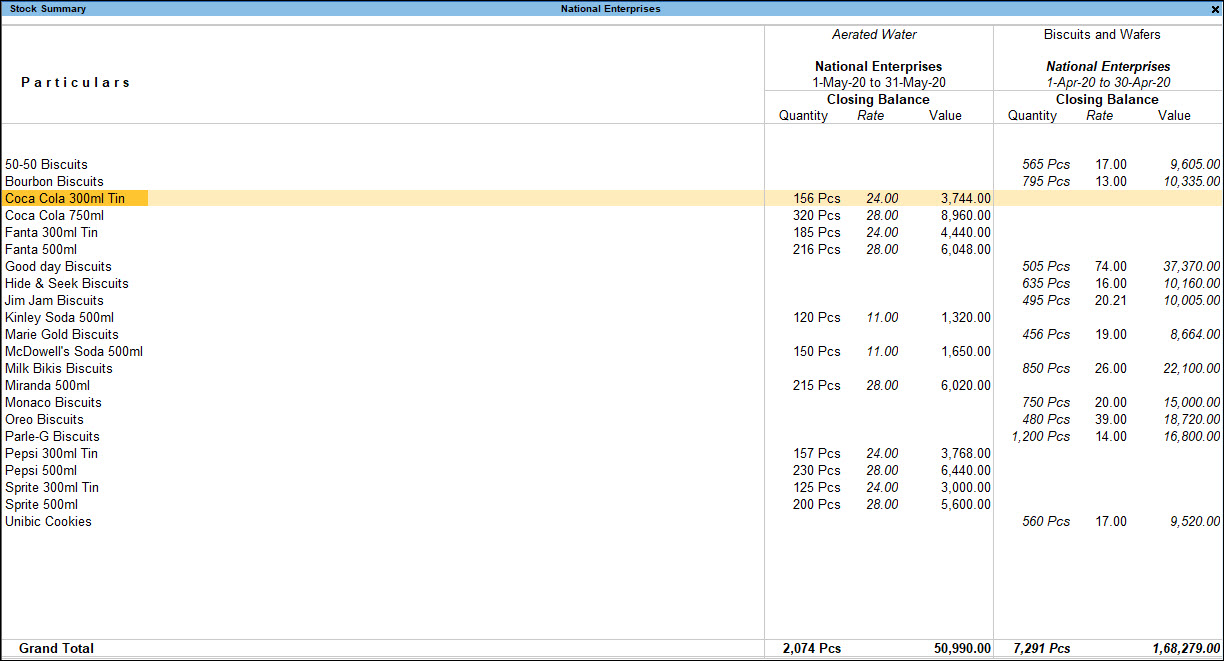
What you see on the screen can vary based on your choices. Press F12 (Configure) to change the options and F11 (Features) to enable or disable features.
- Press Alt+N (Auto Column) to repeat the columns of the current report based on the selected period.
If you want to repeat and compare the data of more than one company, under Auto Column, select Company from the list of options. The Company option is available only when more than one company is open.
- You can alter a column using Alt+A (Alter Column) and delete a column by pressing Alt+D (Delete Column).
Know Your Stock Position
In this section
Stock in hand
When your customers place a sales order, you may not be sure of the quantity that is available with you. You will also need to check if there are any pending sales orders. In this case, knowing the stock in hand or the saleable stock will be helpful.
- In the Stock Summary report, press F9 (Orders) > select Saleable Stock. A sample screen is shown below.


What you see on the screen can vary based on your choices. Press F12 (Configure) to change the options and F11 (Features) to enable or disable features.
Pending sales orders/purchase orders
Say your customers have placed orders for stock items and you want to know what all orders are pending. In this case:
- Press F9 (Orders) > select Sales Orders Outstanding to view all the pending orders.
Knowing this information will help you decide if you can accept further orders or need to place an order with your vendors for more stock.
At times, you may run out of stock and therefore place the required purchase orders with your vendors.
- Press F9 (Orders) > select Purchase Orders Outstanding.
This helps you to know the status of the orders before you can commit to your customers for any new sales order.
Stock position based on Godown Type
If you transact with different vendors or parties to manage inventory for business needs like consignment sales or job work, you will certainly need to keep a tab on the overall situation. Depending on the business needs, you may have stored your stock with your third parties or their stock with you. You can filter the Stock Summary report to view the stock position.
If you have transferred stock to your third party and have maintained a record of the same, on selecting the Our stock with third party option will give you the details of such stock, with their closing balance details.
Assess Value of Stock Items
Each stock item or a group of stock items may have the same or different valuation methods depending on your business. To be able to assess the replacement value or saleable value of your stock, you will need to apply one or more valuation methods across all the stock and compare the values. You can use the Stock Summary report to view the impact of different methods on the value of the stock. You can also know the profit against different stock values.
Say you want to view the values of stock based on last selling rate of the stock and compare with the current stock value. In the Stock Summary report
- Press Alt+C (New Column) and select Last Sale Price as the Method of stock valuation.
This displays the closing balance of your stock based on the last sale price of the stock items. You can view the profit against this value by pressing F7 (Show Profit). A sample image is shown below.
What you see on the screen can vary based on your choices. Press F12 (Configure) to change the options and F11 (Features) to enable or disable features.
Similarly, you can see the stock values and profits calculated for different valuation methods, and understand which valuation method will suit business.
- Press Alt+N (Auto Column) and select Stock Valuation Methods.
To understand more about stock valuation methods and their impact on stock values, refer to the Stock Valuation Methods topic.
View Monthly Summary of Inventory | Stock Item Monthly Summary
The Stock Item Monthly Summary will show the month-wise inward and outward details along with the closing balance of the selected stock item.
- Drill down from the Stock Summary report at the stock item level to open the monthly summary report.
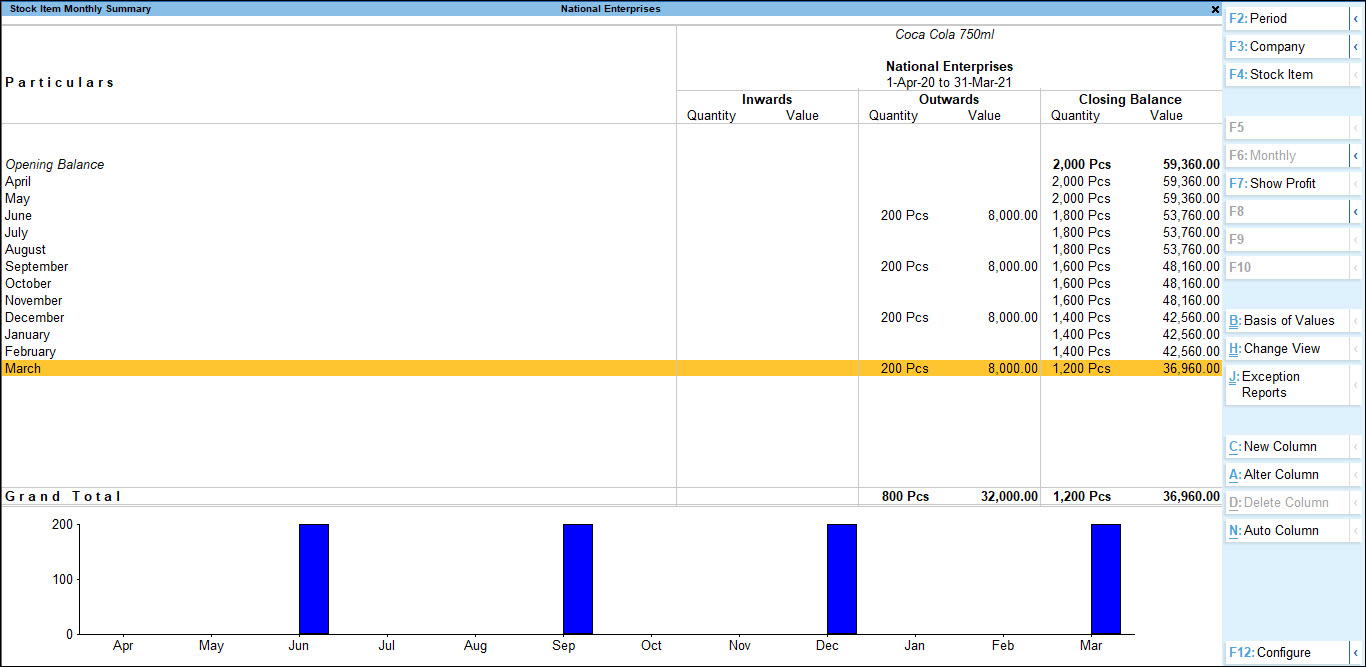
What you see on the screen can vary based on your choices. Press F12 (Configure) to change the options and F11 (Features) to enable or disable features.
Change report context
- Press F4 (Stock Item) and select a stock item to view the month-wise closing balance of the selected item.
View details period-wise
- Press F6 to view item summary based on the period you choose – Monthly or Quarterly.
Like in any other report, press F12 (Configure) or use the buttons on the right button bar to change data representation of the report as you need for your analysis.
View transaction-wise Inventory | Stock Vouchers
The Stock Vouchers report shows the list of vouchers that include the item viewed in the monthly summary report. It also displays other details, like parties that you have transacted with, the total inward and outward quantities, and the closing values.
- Drill down from the Stock Item Monthly Summary report on a particular month to open the Stock Vouchers report.
You can change the period by pressing F2 (Period) to see the transactions done in different months. A sample image is shown below.
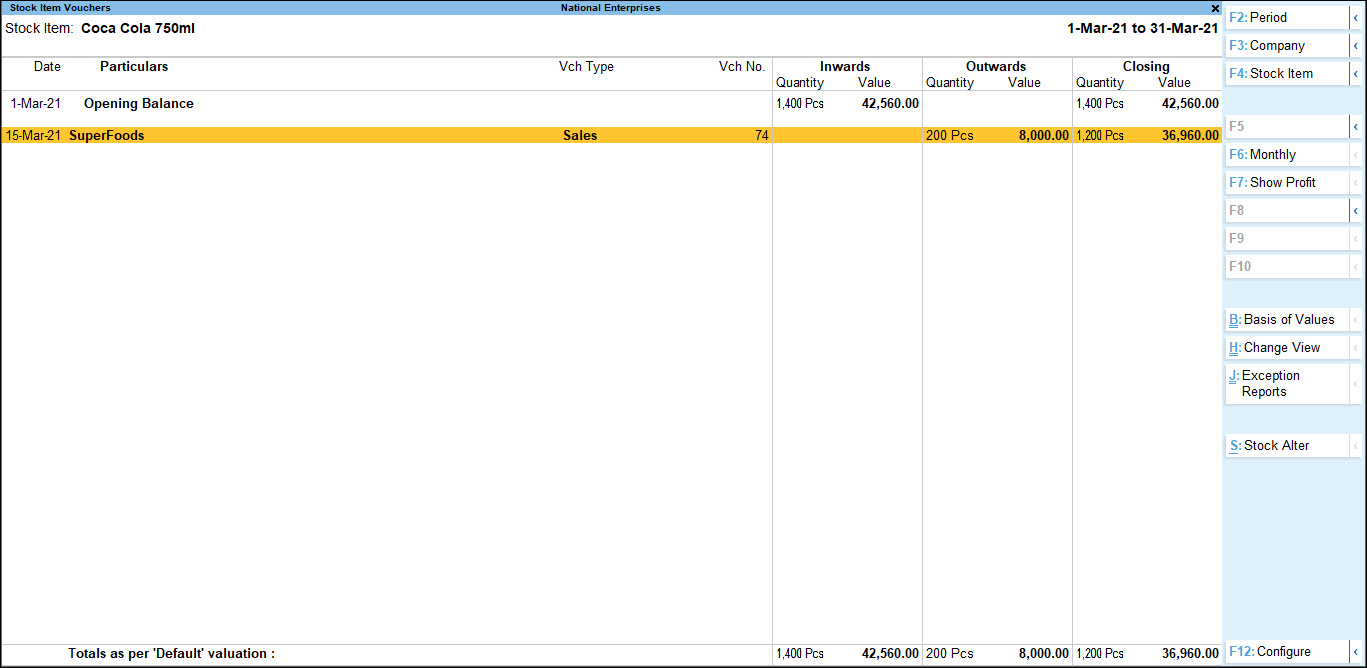
What you see on the screen can vary based on your choices. Press F12 (Configure) to change the options and F11 (Features) to enable or disable features.
Change report context
- Press F4 (Stock Item) and select a stock item to view the month-wise closing balance of the selected item.
View details period-wise
- Press Ctrl+F6 (Daily) to view the day-wise movement of the stock item.
Alter stock item details
- Press Alt+S (Stock Alter) to alter the stock item master for which you are viewing the voucher report.
Like in any other report, press F12 (Configure) or use the buttons on the right button bar to change data representation of the report as you need for your analysis.
- Ctrl+B (Basis of Values): You can configure the values in your report for that instance, based on different business needs.
In Stock Item Voucher, press Ctrl+B (Basis of Values) > Stock Valuation Method > select LIFO, FIFO, or Avg Price, as needed. Press Esc to view the default values.
- Ctrl+H (Change View): You can display the details of a report in different views with additional details or for a specific period. You can also view other reports related to the current report.
To view Monthly Summary, press Ctrl+H (Change View) > type or selectStock Query> press Enter. Press Esc to view the default report.
- Ctrl+J (Exception Reports): You can view the exceptions related to the data displayed in the current report by pressing Ctrl+J (Exception Reports), without closing the report.
To view the Optional Voucher for the Stock Item Voucher report, press Ctrl+J (Exception Reports) > type or select Optional Voucher> and press Enter. Press Esc to view the default report.
